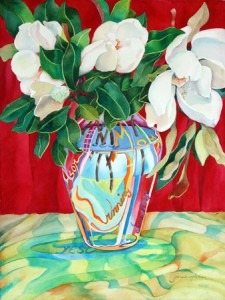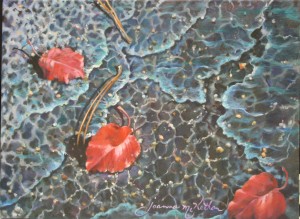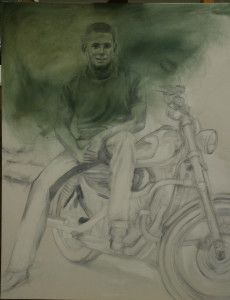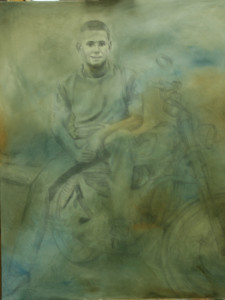Seeing Red Is a Good Thing
‘Seeing red’ is an expression for extreme anger, and cheeks turn red with embarrassment. Red stands for the spilling of blood or fires gone wild decimating acres of timberland.
However, we see red in so many ways that red does not just evoke negative emotions. Hearts in love are typically pictured as red. Red is the heat of a fire or ‘hot’ lipstick. Red is symbolic for the blood flowing through our veins, for life itself–blue inside, but red when it appears from a cut. Red is one of the most beautiful of the fall colors for leaves.
Red shouts the return of spring in canna lilies, tulips, roses, and azaleas. The color red commands attention and speaks hope every bit as much as it says danger. Red is the language of passion.Red is a language of its own that poets speak using various names–carmine, claret, wine-red, burgundy, fire-engine red, crimson, rouge, blood red, blush, rose red, poppy red, valentine, and alizarin crimson.
When I led the Artists Anonymous sessions of creativity at Manna Church in Fayetteville, our group brain-stormed names. This exercise was fun, and opened the mind to expansive use of its faculties rather than fill-in-the-blank answers which tend to limit, control, and shut its faculties down.
 One remembers the seasons by the arrival of velvety red roses. Anniversaries are commemorated with red roses. Mother’s Day is honored by the red rose you wear on Sunday if your mother is alive. I remember red poppies blooming around Mother’s Day, as well, because they filled the ground sections along I-95 enroute to Rocky Mount, NC, the route I traveled for the juried art show I entered every year. In my attempts to advance I often missed being celebrated on that day, but I remember at least one occasion of my daughter’s taking me out to eat and her meeting me upon my return…usually after returning home with my non-accepted paintings.
One remembers the seasons by the arrival of velvety red roses. Anniversaries are commemorated with red roses. Mother’s Day is honored by the red rose you wear on Sunday if your mother is alive. I remember red poppies blooming around Mother’s Day, as well, because they filled the ground sections along I-95 enroute to Rocky Mount, NC, the route I traveled for the juried art show I entered every year. In my attempts to advance I often missed being celebrated on that day, but I remember at least one occasion of my daughter’s taking me out to eat and her meeting me upon my return…usually after returning home with my non-accepted paintings.
Red connotes health, as when we say ‘in the pink of health.’ Late summer is set off by healthy, bright red tomatoes. The delicious tomato-mayonnaise gravy on gooey white bread, a Southern treat, was so delicious just the mention of them by my North Carolina friend at Waldschloessl made me homesick. Red tomatoes were instrumental in calling me home from our Youth with a Mission service in foreign countries surrounding Germany and Austria.
When fall comes, its beauty seems always measured by leaves turning to lustrous shades of red to herald in that season. My early primary family went on fall vacations to the mountains, in particular, Mt. Pilot of Andy Griffin fame, where my father grew up. Our eyes feasted on the view of leaves ever more glorious the higher we climbed. I collect leaves. Even now I have batches of leaves at my studio, waiting for the still life muse to prompt me to leap, set them up and create a new painting. Leaves have occupied some ten or more of my paintings in both oil and watercolor. Two of my red leaf paintings are in Cary, NC. I doodle leaves, as well.
At Christmas, the memory of my father-in-law’s greenhouse filled with rows on rows of red poinsettias he grew to sell fill the season with an aura of his generosity and his permanence. This was one of those things he always did, regular as rain. At some point he would tell us each to come pick one or two out for our Christmas decorations, a major part of our Christmas, his gift to each of us. Red poinsettias just are Christmas, along with all the other red Christmas decorations.
Really, I never realized until I started writing this article how many seasons use red. Add to the aforementioned: one bright red valentine in February. Not getting any shiny red hearts hurts the Charlie Brown’s among us.  Then there is the red of heritage. My McAlester strain is characterized by a bright red tartan.
Then there is the red of heritage. My McAlester strain is characterized by a bright red tartan.
Recently I read an article that claimed sales on red lipstick rose to new heights in a down-turned economy. An odd claim at first, it makes absolute sense. If a woman doesn’t have much to spend to make herself look good, then she buys what gives the most pizzazz for the penny. Red will certainly do that: just thinking about buying red lipstick at the drug store makes my hope surge. Just the other day as I bought the makeup I had forgotten to take with me on my trip to my granddaughter’s, I saw a shade of red lipstick I couldn’t resist. That reminded me of the time I taught Sunday School at a church in Massachusetts, my pastor called me in to ask me not to wear a shade ‘quite so red’ for my internship from divinity school.
Then there is the red carpet treatment one gets as a special favor, such as the runway for celebrities. Maybe I should do more paintings in red. The color certainly seems to sell them. One of my favorites was of red poinsettias floating in deep blue, “Herald,” which was juried into the Durham Arts Council’s annual exhibit by a D.C. major juror, a curator for the Phillips Collection. It sold in Harnett County. One red leaf painting hangs in Cary and another in the complex of buildings that is SAS Institute, Cary, NC, one of the largest privately owned businesses in the U.S. I believe the elephant-sized painting of bubbles that hangs in the insurance building in Raleigh sports a lot of reds.  Just for fun, I’ll include samples of sold and unsold paintings with red in them.
Just for fun, I’ll include samples of sold and unsold paintings with red in them.
One of my students who branched out to take a weekend course in Raleigh was told that in her beach scenes, one should never paint a walker wearing any red apparel. Tell that to some of the greats in museums, right? I suppose the taboo of today shows you ‘know’ what and who the current trendsetters are. Telling most artists not to paint something red is more than likely, however, just to make them see redder. Which reminds me of another way of seeing red–Spanish bullfighters waving the red scarf in front of the bull to make him charge. It definitely inflames the eye!
There’s a little bit of red in my most recent commissioned portrait, in the plaid of the little boy’s shirt. I changed his sweatshirt top to the plaid shirt in other pictures, and it ‘made’ the picture, my client said. Along with capturing his essence, which is what his mother claimed the painting did. In another article we’ll examine all the different red paints, which ones are reliable, and which ones we are told to avoid. Right now, I need to rest my eyes on a little gray.
Learn more »







